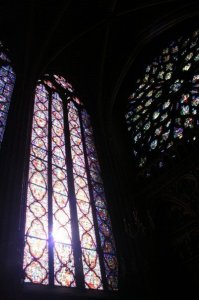For each of the 12 days of Christmas we have asked Apollo staff and contributors to select the artistic highlights that they are most eagerly anticipating in 2014. The Muse Room will return with its regular daily blogs on 7 January 2014. From all of us at Apollo, happy new year!
Although relatively little known compared to other sites in Paris, the Sainte-Chapelle is certainly one of the masterpieces of ‘Rayonnant’ Gothic art and architecture in the French capital.
Saint Louis (King Louis IX of France) commissioned its erection within the royal palace complex. After its consecration in 1248 the chapel housed his collection of precious relics, including Christ’s Crown of Thorns purchased in Venice at vast expense in 1239.
 Following an extensive restoration campaign, it is hoped that the Sainte-Chapelle will reopen this year on the 800th anniversary of the birth of Louis IX. Hailed in his lifetime as an exemplary Christian prince, Saint Louis favoured art and education in France over military domination. Under his long and benevolent reign, France reached unprecedented cultural heights. He founded a renowned college of theology that later became known as La Sorbonne and commissioned many magnificent works of art and illuminated manuscripts.
Following an extensive restoration campaign, it is hoped that the Sainte-Chapelle will reopen this year on the 800th anniversary of the birth of Louis IX. Hailed in his lifetime as an exemplary Christian prince, Saint Louis favoured art and education in France over military domination. Under his long and benevolent reign, France reached unprecedented cultural heights. He founded a renowned college of theology that later became known as La Sorbonne and commissioned many magnificent works of art and illuminated manuscripts.
The original stained glass windows – arguably the most important of the period – that survived the pillage of the Revolution will be restored to their former glory. The visitors may find themselves, in the words of scholar Jean de Jandun in his Tractatus de laudibus Parisius in 1323, ‘as if rapt to heaven, to enter one of the best chambers of Paradise.’
The restoration work at the Sainte-Chapelle is due for completion in 2014.

12 Days
Detail of stained glass window, Sainte-Chapelle Photo: Didier B
Share
For each of the 12 days of Christmas we have asked Apollo staff and contributors to select the artistic highlights that they are most eagerly anticipating in 2014. The Muse Room will return with its regular daily blogs on 7 January 2014. From all of us at Apollo, happy new year!
Although relatively little known compared to other sites in Paris, the Sainte-Chapelle is certainly one of the masterpieces of ‘Rayonnant’ Gothic art and architecture in the French capital.
Saint Louis (King Louis IX of France) commissioned its erection within the royal palace complex. After its consecration in 1248 the chapel housed his collection of precious relics, including Christ’s Crown of Thorns purchased in Venice at vast expense in 1239.
The original stained glass windows – arguably the most important of the period – that survived the pillage of the Revolution will be restored to their former glory. The visitors may find themselves, in the words of scholar Jean de Jandun in his Tractatus de laudibus Parisius in 1323, ‘as if rapt to heaven, to enter one of the best chambers of Paradise.’
The restoration work at the Sainte-Chapelle is due for completion in 2014.
Share
Recommended for you
Fragile Histories
Edmund de Waal creates an atmosphere of meditation at the Fitzwilliam Museum with the display ‘On White: Porcelain Stories’
Darkness Visible
‘Paul Klee: Making Visible’ at Tate Modern is rigorous but incurably serious – is it the right setting for such complex and colourful work?
Show and Tell
Leonora Carrington may be a ‘literary painter’ and a surrealist storyteller, but we should not forget the formal qualities that underpin her best work